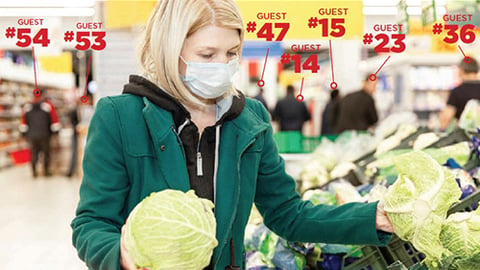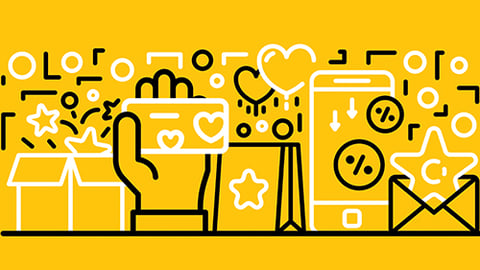Upgrading Employee Engagement
The speed of change has never been so great in food retail as it is today, amid the COVID-19 pandemic. Policies and procedures have needed to shift at a moment’s notice, and management is counting on associates to implement many of these changes.
Key Takeaways
- Employee engagement is the answer to making associates feel safe at work, and ready to adapt quickly to new processes.
- An app in a much more intuitive format, closer to what employees use outside of work, can help with adoption.
- Greater communication between upper-level management and hourly employees can have a positive impact on worker confidence.
Employees are seeing new sanitation protocols, occupancy counting, social-distancing signage, mask requirements, item limits and a whole list of tasks to be done, but communication can be one of the greatest hurdles to execution.
There’s no time to send down PDFs from the top of the organization, and binders of data are outdated almost as soon as the pages come off the printer.
Personal situations are also changing at record speeds. Although many grocers are aggressively hiring more than firing, employees’ spouses or family members may have lost their jobs or become sick, making associates’ paychecks that much more crucial.
Employee engagement is the answer to making associates feel safe coming into work, and ready to adapt while on the job in a timely and complete manner.
“You’re at your job for most of the day, and we believe that true engagement comes from knowing that you have the ability to make change within an organization, and you see how your actions are supporting the greater good of what the company’s trying to do,” says Melissa Wong, CEO of San Francisco-based Retail Zipline. “Associate engagement is actually key to execution.”
A number of technology solutions focused on communication have gained traction during this crucial time, making employees’ jobs easier, keeping morale high and having a quick return on investment for the companies.
In Workers’ Hands
According to Wong, Retail Zipline’s communication and task performance technology helps companies with the four types of communication in retail environments: what you need to know, what you need to do, policy and procedure, and dialogue, discussion and debate.
In May, Hy-Vee announced a partnership with Retail Zipline, which has a consumer-like mobile and desktop app to help streamline communication. Wong notes that a conversation with the West Des Moines, Iowa-based retailer was in the works before COVID-19, but Hy-Vee implemented the solution faster than planned, due to immediate need.
“So many technologies have left retail behind; they’ve left the hourly worker behind,” Wong says. “[Hy-Vee was] looking to make it easier on the store employee to understand what they needed to do for their day-to-day. And then with coronavirus, the CEO wanted a direct conduit to talk to his people.”
Known for its digital workplace, Montreal-based WorkJam has partnered with a number of food retail clients, including Australia-based Woolworths, as well as The Kroger Co. and Target.
WorkJam’s technology works with a bring-your-own-device (BYOD) model, something that Will Eadie, the company’s global VP of sales and alliances, says has currently become more of the norm.
Easy to Use
Most employees are comfortable with smartphones in this day and age, so having an app in a much more intuitive format, closer to what they use in their daily lives outside of work, can help with adoption.
“If you make people’s lives easier, you’re definitely driving the self adoption into the technology,” Wong affirms. Retail Zipline has seen first-week adoption at typically around 90%.
To encourage adoption at Hy-Vee, Retail Zipline is donating a dollar, up to $25,000, to local food banks for every associate who logs in. Hy-Vee is also matching these donations.
“I really believe that stores have the opportunity to be the best manifestation of the brand and such a focal point in the community,” Wong says. “We wanted to make an individual store person feel like they can make an impact on giving to the community, even if they couldn’t actually donate themselves.”
WorkJam’s platform has combined the functionality of a number of disparate systems often seen in retail to handle communications, tasks, learning and time-off requests all in one place, making all of these features more straightforward for the employee.
“Tasks have always existed, whether they’re on a checklist or a store walk or an audit,” Eadie notes. “What’s really important now is that they can’t be separate from communications. We typically see adoption around 87% weekly active users. Traditional intranets, just by the way, generally have a below 20% weekly average user rate.”
Eadie also credits WorkJam’s ability to geofence content as another reason for fast adoption.
Employees still have the ability to communicate with each other outside of work, but compensatory time laws aren’t a concern, as content such as the store checklist or a message from the CEO is consumable only when an employee is on site or on shift.
Easy adoption is also a selling point for New York-based DailyPay, a technology platform delivering early earned-wage access to employees that has seen increased demand from employers during the COVID-19 pandemic.
Increased Flexibility
Cincinnati-based Kroger began offering what it’s calling ExpressPay, powered by DailyPay, to its employees in late April.
From an employer standpoint, DailyPay integrates with all HR/HCM/payroll systems, the employer isn’t charged for offering the service to its employees, and DailyPay has raised a line of credit to support the early-access dollar amounts, so the company doesn’t have to change anything about how it processes payroll.
Employees can download a user-friendly app to access their earned wages — less any taxes or deductions, voluntary or mandatory — at any time. There’s also a saving feature if employees want to hide money from themselves. Fees for accessing the funds can range anywhere between $2.99 and $3.49, depending on same-day or next-day delivery, or their company.
“What we’ve seen is some companies will actually cover that cost for their employee, or they’ll subsidize it,” Mullen observes. “With Kroger, next-day access to their money is free, forever. For everybody outside of Kroger, which their next-day hasn’t been free, we’ve actually waived it during the pandemic, because we want people to have their money.”
Mullen describes the two groups most of DailyPay’s users fall into: ERINs and MAGGIEs. ERINs are those Employees who Require Income Now, while MAGGIEs are those Millennials And GenZ who Get Instant Everything. This second category is particularly interesting as the gig economy continues to take hold.
“People were seeing this rise for on-demand services come up, and companies really didn’t know how to take care of their employees in an on-demand type of environment,” Mullen explains. “They were asking people to do all these on-demand things, but then to wait a week or even two weeks to get paid. A lot of the people … were taking these jobs either as second jobs, or because they lost their jobs somewhere else, and they were urgently looking for a way to support their family.”
Many employees with steady hourly jobs are still looking for flexibility during these uncertain times, and technology can be the answer to that as well. Mullen views the ability for employees to receive pay on demand, or even just see their earned wages, as motivation to work harder.
“We do all these studies, and we started to see that DailyPay employees were becoming three times more productive than people not using DailyPay,” she asserts. For many hourly employees, this is the first time they can see exactly what they’ve made thus far, spurring them to pick up extra shifts or not call off before payday.
Productive Benefits
Since the coronavirus pandemic began, food retailers have had to instill confidence in both their employees and customers that they’re doing everything possible to minimize risk and make people comfortable coming into work or shopping in their stores.
In response, WorkJam almost immediately rolled out a health check module that’s highly specific to the pandemic. Many of its customers have made this survey mandatory before employees start a shift, having them answer basic health questions such as: Are you sick? Do you feel comfortable coming to work? Have you been around anyone sick? Do you feel safe?
“Once they’ve answered that, they can actually earn the first level of a digital health badge, which then maybe takes them into a training, which might be a five-minute video from the head of HR [or] the head of safety,” Eadie notes. This video could include new procedures on handwashing, or updated policies.
“If you don’t have a tool that you’re using at the site level,” he adds, “it means you have no ability to do any reporting around compliance, or efficiency, or engagement at the corporate level.”
Retail Zipline has seen the impact that greater communication between upper-level management and hourly employees can have on worker confidence.
“The biggest thing for engagement now is really understanding,” Wong asserts. “It’s really saying, based on how my employees are feeling and their state of mind today, am I able to engage them, either around information that will make them feel better, because we have better health and safety standards, or around product information? Really, it’s meeting people where they’re at to be able to even start the conversation.”
WorkJam’s Open Shift Marketplace creates an on-demand labor pool to help companies fill a need for more workers and help employees pick up additional shifts, something Eadie says will only continue to grow in importance after COVID-19.
Using intelligent filtering, only qualified workers will be able to see and pick up certain shifts. A complete rules engine allows retailers to support both union and nonunion environments as well.
Even if the speed of change in food retail slows down once COVID-19 concerns wane, systems put in place now to enhance communication, tasks, pay and training will continue to pay dividends.









